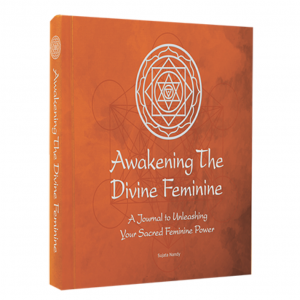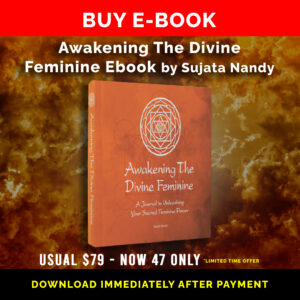Applauded with magical and supernatural powers, yoginis are India’s tradition of women who have provided much curiosity and intrigue to those keen on the study of the Goddess and the Mahavidya. Considered as a cult, consensus has it that the cult first appeared around the 6th to 7th Century, gaining popularity in the 9th Century till it reached its peak, in the 12th Century.
According to many scholars of the time, the foundations of Yogini veneration are outside the typical orthodox Brahmanical practices – tantric in nature with strong relations with rural and tribal traditions of the time.
The origin of the Yoginis has been recorded to be in small, rural villages, believed to be the Guardian Goddesses (Grama Devatas), of the isolated villages dotted throughout ancient India. They are mentioned in the Skanda Purana variously as yoginis, dakinis, shaktis or bhairavis. Dakini is a term used to describe a ‘sky dancer,’ female messenger or attendant with supernatural abilities practicing various forms of secret tantras. Later, the term yogini, as used in the Chandi Purana referred to the form of Devi, the Supreme Goddess. Each of the yogini was seen as a different part of the Devi’s body. The term dakini is still retained in the Buddhist tradition which refers to sorceress, witch or even ghoul.
Able to impart magical powers to their worshipers and bestow wisdom (vidya), that are still till today, regarded as unrivaled and unmatched by any other wisdom of the similar strain. Some of the wisdom that were imparted by these Guardian Goddesses are: anima (the ability to become very small), laghima (the power to levitate and to be able to leave your body at will), garima (the power to become very heavy), mahima (the power to become large in size), istiva (the power to control the body and mind of oneself and others), parakamya (the power to make others do your biding), vasitva (the power to control the five elements) and kamavasayitva (the power to be able to fulfill all your desires).
The objective of the cult was to cultivate supernatural powers. They deemed themselves as servants of the Mother Divine. They were devotional in nature, linked to black tantrism using the destructive energies of Kali and Bhairavi but that hardly makes them witches! Their central focus of worship was Bhairavi, Kali and Shiva Bhairava, using destructive energies of Kali or Bhairavi with a positive goal.
The practice of the 64 Yoginis is one of the most esoteric and powerful of all tantric practices. Yogini means “power of union,” or “the power that facilitates union.” In tantric mythology, yoginis are described as fertility goddesses. They are innumerable—some yoginis are benevolent while others, fierce, some rule over our negative tendencies while some others, over our positive ones. Together, they create a condition both inside and outside us conducive to finding lasting fulfillment. These prevalent forces influence our thoughts, speech, and actions. Our likes and dislikes are inspired by them for ¬They cloud our consciousness as well as clear it.
WHY 64?
Over the years, these village Goddesses gradually transformed and merged into powerful numerical groupings with the numeric varying from text to text. Presented as a band of warrior Goddesses, there are very few references to yoginis being alone. The number eight is regarded as propitious and have great power in the Hindu religion. As the square of eight, sixty-four, has even more power and is exceptionally auspicious in Tantric literature. When the Yoginis are divided into groups of eight, they are usually associated with a specific deity directly related to their own attributes and supernatural powers.
A look into the ancient Tantric tradition reveals a sacredness transferred to the number eight – the eight mother faculties (tatvas) of the manifested Universe, the eight directions with four cardinal and four intermediate points (digbandahs), the eight miraculous yogic powers (ashta siddhis), eight “limbs,” of Yoga (ashtanga), eight forms of the Divine Mother (ashta matrikas), are just some illustrations.
The number 64 compares to the currents or wind of the human body as a type of unproductive tendency. 64 also has its mystical use in Tantric rituals and numerology to get magical powers. A representation of the sixty-four Yoginis is found on the ancient Khechari Yantra with each of its sixty-four petals representing one of these Yoginis. The sixty-four practical techniques (kriyas), of trance and transformation relate to the Yogini energies within nature, all of which interact together to produce spiritual growth when the appropriate catalyst is available – their purpose is to pull souls out of illusion. This is exactly the significance of both the sixty-four hexagrams seen in the Taoist tradition as well as the sixty-four yoginis of the Shakti Tantric tradition. The Tantric literature itself is said to be comprised of sixty-four spiritual books, also referred to as Tantras. In this sense, the word tantra conveys the meaning of “canonical manuscripts.”
Comparable references in classical literature includes the sixty-four yogic induced paranormal powers (siddhis), the sixty-four divisions of the arts (kalas), and, within the ancient Saiva Siddhanta tradition, the sixty-four saints (nayanars). There are also sixty-four forms of Bhairava, sixty-four tantric mudras, as well as sixty-four siddhas, beyond even the 18 Maha Siddhas, which are more commonly celebrated, and so on.
This sacred number is closely connected with power and life itself. In the Indian classic, Mahabharata, Lord Krishna fired sixty-four arrows into the battlefield and in a separate battle, Bhishma’s armour was pierced sixty-four times.
Most importantly, the sixty-four Yoginis are regarded as fundamental emanations of the great Goddess Kali with different aspects of creation, having very distinct personality, and offering doorways into immense yet, magical awareness.
Kali is in all forms. She when Her 64 Yogini Namavali is chanted, becomes extensions of Her Cosmic Personality and bestows infinite possibilities to the sadhaka.
YOGINIS IN TRADITION
The yoginis are often associated with a sense of fear and awe because of how they are fashioned with demonic expressions and terrifying dark attributes that describe their characteristics and mannerisms. Ancient texts depict the sculpture of these yoginis with heads of other flying creatures such as: parrots, hawks, peacocks, eagles, pigeons, and owls with characteristics from other animals such as, the frog, elephant, jackal, goat, ox, cat, tiger, horse, and snake. Along with having the qualities of birds and other animals, the yoginis are recurrently spoken of as having severed heads in their hands or scattered around their feet. In one story as told in the Padna Purana, the yoginis were called by Lord Shiva to consume mounds of flesh from a demon’s head that He had severed. This story described how they rejoiced after eating the flesh and drinking the blood of the demon and portrayed them as having massive bodies, numerous arms (usually between 4 and 8), and having long, sharp fangs.
There are four main traditions that relate to the cult of the yoginis and how they established from their tribal beginnings and became assimilated into orthodox beliefs. All four of the traditions revolve around the idea that the yoginis were minor divinities who later ascended to greater Goddesses.
The FIRST TRADITION is the idea of the yoginis as aspects of the Devi or the Great Goddess. The yoginis were said to be formed from different parts of the Devi, including: Her voice, sweat, navel, forehead, cheeks, lips, ears, limbs, toe nails, womb, and Her anger.
The SECOND TRADITION is the idea that the yoginis are attendant deities of the Great Goddess. This tradition is thought to have developed from earlier tradition of Shiva and His gana attendants.
The THIRD TRADITION focuses on the yoginis as acolytes of the Great Goddess: the matrkas. This tradition describes the yoginis as being born of eight mothers and formed into eight groups.
The FOURTH TRADITION centers on the thought of the yoginis as patrons of the goddess of the Kaulas. Through the scrutiny of numerous Tantric texts, the yogini cult became associated with a specific Tantric sect called the Kaulas.
YOGINI WORSHIP
In Yogini worship, the Tantrik symbol is a chakra with 64 spokes in a wheel. Each spoke represents a Yogini form of the Devi. In the Buddhist Kalachakra tantric system, the navel chakra or the Wheel of Emanation, the 64 channels are the 64 goddesses of the Speech Mandala.
Bhairavi is experienced in Her wrathful form in a practice known as Bhairava Chakra. In the 9th chapter of the Kaulajnana Nirnaya presents the 8 chakra system stating that the 64 yoginis are Kama-rupa. This means the ‘desire form,’ a way of referring to this reality where forms are born out of desire.
By meditating on each of the 64 petals, one induces the resident yogini to grant a boon in the form of siddhi (mastery). In the Kaula tradition, secrets of bodily perfection lie in the 64 fold complex matrices with sadhana or ritual involving the 5 M’s: Matsya – fish, Mamsa – meat, Mudra – parched grain, Madya – alchoholic drink and Maithuna – sexual intercourse. Maithuna here is usually misquoted; so is Tantra wrongly attributed to black magic.
YOGINI MANDHIR
Like the Stonehenge, Gobekli Tepe, and other ancient temples, all of the sixty-four Yogini temples are open to the sky and are constructed in a circular fashion, as if the yoginis sat in their own circles observing rituals as a band of sacred women. As it should be, there is no single sixty-four Yogini temple having identical deities to any other. Each Yogini temple is amazingly unique in that respect, where each Yogini has Her own individual recess or seat and all Yoginis face the center of the temple.
There are five Yogini temples in sacred India that have, to varying degrees, endured the centuries. All have received substantial damage, but the original energy produced by the powerful techniques of tantra remains in each of them. Each Yogini temple in India has a unique shakti cluster. None are the same. The identification of these sixty-four varies, both in the temples and the literature.
Yogini sadhana involves many aspects but a key principle is that, for the Shakta, each of the sixty-four Yoginis is worshipped verily as one’s sexual partner. Shiva becomes the key form of devotion for the Shakti. When joined with the sixty-four tantric kriyas and performed with high consciousness, the practice leads to a substantial increase in auric energy and experiences of inward bliss. The techniques can be learned only from a qualified guru of the yogini tradition. It is widely understood that these practices including the Chakra Puja were performed by spiritual clans (kulas), at these great temples.
Om Kali Nitya Siddhamata Swaha!
Photo credit: Laura Amazzone
SUJATA NANDY WORLD GURUKUL
www.sujatanandy.com







